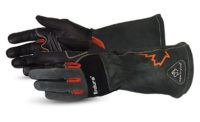When talking about the biggest pain points customers face, cut resistance always tops the list. There’s lots of confusion from what makes a glove cut-resistant, to which level (yes, there are levels) of cut resistance is best.
To ease the confusion, we’ve compiled a list of ten tips for choosing the right cut-resistant gloves.
You don’t need the highest cut glove
In most cases, it’s a call from a worried manager who is looking for solutions after an injury, but buying a glove with the highest level of cut resistance on the market is not the best way to stay safe.
Here’s why:
Gloves are made cut-resistant through synthetic fibers like Kevlar® or Dyneema®. These fibers are wrapped around thin strands of steel or fiberglass.
The more cut-resistant properties that a manufacturer wants their glove to possess, the more of these fibers they need to combine. This leads to bulkier gloves.
Extreme cut-resistant gloves are designed for very specific tasks, like changing slitter blades in paper mills or handling steel cables. Jobs were fine hand movement is not a concern but protection from severe cuts is paramount.
If you don’t face those risks, a glove with lower cut-resistant properties will keep you well protected and save you money.
Don’t mistake your glove for being cut-proof
Your glove is not cut-proof. Your coworker’s glove is not cut proof. Do not treat your glove like it is cut-proof. There is no glove that will protect you from a band saw, table saw, or any other electric motor driven cutting tool. There’s no further explanation needed for this, don’t let your glove give you a false sense of security.
Educate yourself on the tests that measure cut resistance
There are two major standards for measuring cut-resistance, ANSI/ISEA 105-2016 and EN388. ANSI/ISEA is used in North and Central America. EN388 is used, by law, in Europe, and commonly used in South America, Asia and Australia.
Without diving too deep into these standards, we recommend using the ANSI/ISEA 105 standard over the EN388 standard – unless legally obligated – because it is a more true-to-life test method.
If you aren’t sure which standard your glove is tested to, review the icons on your glove. If it has a CE symbol with a series of numbers, it was tested to the EN388 standard.
Pick a yarn that does double duty
Kevlar® and Dyneema® are the two most well-known cut-resistant fibers on the market. Both are inherently cut-resistant and both have similar properties of cut resistance.
When you’re choosing which yarn material to go with, consider other factors like:
- Do you need thermal heat protection?
- Do you need sub-zero protection?
- Is the area where you work incredibly hot?
- Are you going to be sweating in the glove?
- Are you working around sparks?
- Will you need to bleach the glove? (Pertinent for those working in food industry)
Kevlar® has exceptional extreme temperature properties. It can withstand heat upwards of 850°F and cryogenic temperatures of -320°F. It also works well around sparks. Dyneema® is a more breathable fabric than Kevlar®, it pulls moisture away from the skin and feels cool to the touch.
When you’re choosing cut-resistant gloves, make sure that they can perform as many tasks as possible to get the most bang for your buck.
Learn about gauges
The yarn used to make string-knit gloves comes in a variety of thicknesses. This is measured by its diameter, or gauge. Our gloves range anywhere from a thick 7-gauge to an impressively thin 21-gauge.
Each gauge will have its strong suits. For instance, thicker gloves (7- to 13-gauge gloves) are necessary when you need better abrasion-resistance because they don’t wear through as fast. Thinner gloves (15- to 21-gauge) are necessary when you need more dexterity, like dealing with small parts.
Remember that gloves are your last resort
Simple fixes are never the best fixes – WD-40 and duct tape work in a pinch, but don’t expect them to hold forever.
Gloves (or any PPE) should never be your first method of protection. Remember the hierarchy of controls – elimination, substitution, engineering controls, administrative controls, PPE. Before you bring gloves into your plan for keeping employees safe, look at ways to mitigate risks and remove harm from the scenario.
Embrace engineered yarns
An engineered yarn uses two or more components to make a yarn that is stronger than either of the components would be on their own. For instance, taking a strand of steel and wrapping Kevlar® yarn around it. Now you have a yarn that is comfortable (thanks to the Kevlar®) and highly cut-resistant (thanks to the steel reinforcement).
Engineered yarns allow you to have incredibly thin gloves that are impressively cut-resistant. It’s like adding rebar to concrete; it’s taking something that’s strong and making it even stronger.
Leather can be cut resistant (but it’ll cost you!)
Leather is not inherently cut-resistant – it’s the skin of an animal, meaning that it’s as cut-resistant as your own skin (not very).
But, leather can be made cut- resistant by using a liner made of Kevlar® or Dyneema®. There are benefits to this for anyone who needs cut protection but also needs gloves that hold up to abrasion from ropes or concrete.
At the end of the day, you need to weigh the cost of a cut-resistant leather glove versus the use you get from it.
Avoid trying to test cut resistance yourself
Our sales team has heard of various field tests performed to see if gloves are cut-resistant – box cutters, scissors, table saws and machetes (they’ve heard it all).
Cut tests are designed by scientists and engineers to represent real-world risks. No cut-resistant glove is designed to stop a pair of scissors, so you shouldn’t expect the glove to withstand that. If you’re unsure of the cut-resistance of your glove, ask your local rep for the glove’s cut documentation.
Choose the level of cut resistance that is appropriate to your hazards
If you’re moving boxes or working in metal panels, you may only need a low level of cut-resistance, anything over level A4 would be too much (and too costly).
But on the flip side, if you’re working with high cut risks, like sheet metal or slitter blades, you need to be conscious of choosing adequate protection. You can’t expect that a glove designed for nuisance cuts will protect you from serious lacerations.
Conclusion
Choosing a cut-resistant glove isn’t meant to be difficult, but it will take some time to understand what you need to look for. By reviewing your risks, the options that are available and the types of jobs that you’re doing, you can choose the best cut-resistant glove for you. Determine the risks and make a choice based on those calculations.



